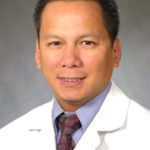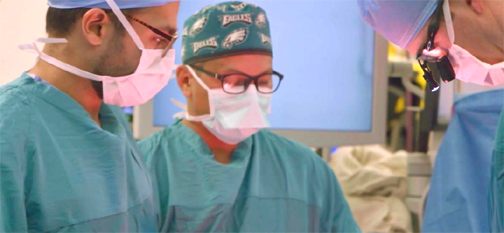UP Medicine grad makes medical history in Pennsylvania
PHILADELPHIA — A young Filipino American doctor was on a team of surgeons from the Perelman School of Medicine at the University of Pennsylvania that became the first in the world to use a surgical robot to assist with a bilateral free flap breast reconstruction.
The procedure involves taking a tissue from the lower abdomen — similar to a “tummy tuck” — and using it to rebuild the breast.
Dr. Ian Soriano, a graduate of the University of the Philippines College of Medicine and a clinical assistant professor of surgery at the University of Pennsylvania, partnered with Dr. Suhail Kanchwala, an associate professor of plastic surgery, who led the team that performed the procedure, which took place at Pennsylvania Hospital earlier this month.

Dr. Ian Soriano
The robot allows surgeons to make a much smaller incision into the abdominal wall muscles, allowing patients to recover and be discharged more quickly and without the use of addictive narcotic painkillers.
Soriano, who specializes in minimally invasive procedures, teamed up with Kanchwala to develop the technique.
Women who have chosen a mastectomy, either to remove cancerous breast tissue or as preventative measure due to genetic risk, have several options for reconstruction.
Kanchwala said traditionally, using a patients’ own tissue results in a more natural appearance and is a more permanent solution when compared to implant-based reconstructions, which often require additional surgeries.
“This is great news to breast cancer patients all over the world, particularly those in the Philippines,” said Soriano, who graduated from a combined undergraduate-medical degree program at the UP College of Medicine in Manila, where he was an active member of the Alpha Sigma Fraternity.

Dr. Ian Soriano (center) with Dr. Suhail Kanchwala and another surgeon during the breakthrough robotic bilateral great reconstruction surgery. PERELMAN SCHOOL OF MEDICINE, UNIVERSITY OF PENNSYLVANIA
The Philippines has the highest incidence of breast cancer in Asia with the highest increase of almost 500 percent over a 30-year period from 1980 to 2010.
“Given that we are able to do this approach both robotically and laparoscopically (both done with small incisions), I believe that the technique is reproducible in the Philippines,” Soriano said.
“Provided, however, that a plastic surgeon who specializes in microvascular surgery and an advance laparoscopic surgeon team up and work together to learn the technique and choose well their patients who will benefit from this procedure.”
He said that while there are a significant number of advanced laparoscopic surgeons who perform laparoscopic hernia repair in the country, there are fewer than 10 surgeons in the Philippines with significant microvascular surgery experience.
“So this would be the main limiting factor to adapting this technique in the Philippines,” he said.

